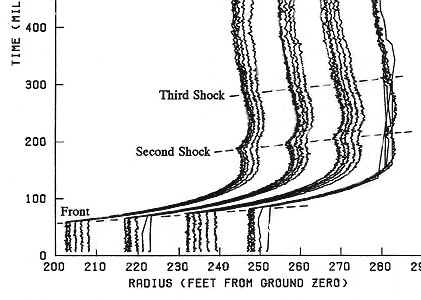
Flow tracer measurements provide particle trajectories, like those above, for use in the numerical reconstruction. The trajectory closest to the charge is used to define a piston path, or moving boundary which drives a numerical, hydrodynamic calculation. Using such a moving boundary avoids the need to simulate the complete detonation/explosion process. The piston trajectory may be adjusted slightly so that the results of the hydrocode calculation agree with all of the other measurements made in the experiment. Numerical reconstruction also calculates physical properties such as density, temperature and energy flux, which are difficult or impossible to measure by other methods. The numerical analysis reconstructs all the observed data and moreover provides a complete description of all the physical properties of the blast wave at a fraction of the computing 'cost' of a numerical simulation.